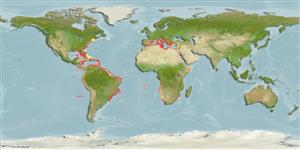Cephalopoda |
Octopoda |
Octopodidae | Octopodinae
Environment: milieu / climate zone / depth range / distribution range
Ecology
Benthic; depth range 50 - 800 m (Ref. 275), usually 100 - 400 m (Ref. 275). Tropical; 45°N - 31°S, 89°W - 36°E (Ref. 107080)
Indo-Pacific, Atlantic and the Mediterranean.
Length at first maturity / Size / Weight / Age
Maturity: Lm 5.0 range ? - ? cm Max length : 12.0 cm ML male/unsexed; (Ref. 104052); common length : 8.0 cm ML male/unsexed; (Ref. 104052)
Minimum depth from Ref. 104052. Littoral. On muddy bottom (Ref. 2082). Inhabits areas with low light levels (Ref. 106818). Associated with coralline bottoms ( Ref. 275). Capable of various color patterns, skin textures and body postures (Ref. 106818). Octopods are carnivores, preying mainly on crustaceans, fish and shelled mollusks (Ref. 96968).
Life cycle and mating behavior
Maturity | Reproduction | Spawning | Eggs | Fecundity | Larvae
Members of the class Cephalopoda are gonochoric. Male and female adults usually die shortly after spawning and brooding, respectively. Mating behavior: Males perform various displays to attract potential females for copulation. During copulation, male grasp the female and inserts the hectocotylus into the female's mantle cavity where fertilization usually occurs. Life cycle: Embryos hatch into planktonic stage and live for some time before they grow larger and take up a benthic existence as adults.
Roper, C.F.E., M.J. Sweeney and C.E. Nauen 1984 FAO Species Catalogue. Vol. 3. Cephalopods of the world. An annotated and illustrated catalogue of species of interest to fisheries. FAO Fish. Synop. 125(3):277p. Rome: FAO. (Ref. 275)
CITES status (Ref. 108899)
Not Evaluated
Not Evaluated
Threat to humans
Human uses
Fisheries: commercial
| FishSource |
Tools
More information
Trophic EcologyFood items (preys)Diet compositionFood consumptionPredators PhysiologyOxygen consumption
Human RelatedStamps, coins, misc.
Internet sources
Estimates based on models
Preferred temperature
(Ref.
115969): 10.5 - 22.1, mean 14.7 (based on 459 cells).
Fishing Vulnerability
Low vulnerability (10 of 100).
